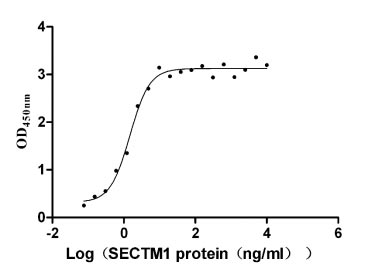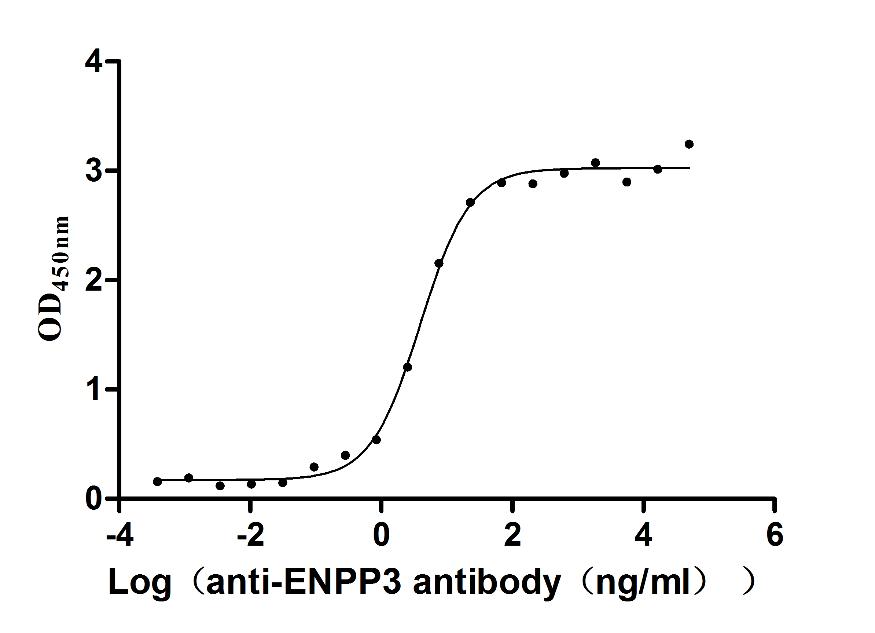Recombinant Human ATP-sensitive inward rectifier potassium channel 8 (KCNJ8), partial
-
货号:CSB-YP613604HU1
-
规格:
-
来源:Yeast
-
其他:
-
货号:CSB-EP613604HU1
-
规格:
-
来源:E.coli
-
其他:
-
货号:CSB-EP613604HU1-B
-
规格:
-
来源:E.coli
-
共轭:Avi-tag Biotinylated
E. coli biotin ligase (BirA) is highly specific in covalently attaching biotin to the 15 amino acid AviTag peptide. This recombinant protein was biotinylated in vivo by AviTag-BirA technology, which method is BriA catalyzes amide linkage between the biotin and the specific lysine of the AviTag.
-
其他:
-
货号:CSB-BP613604HU1
-
规格:
-
来源:Baculovirus
-
其他:
-
货号:CSB-MP613604HU1
-
规格:
-
来源:Mammalian cell
-
其他:
产品详情
-
纯度:>85% (SDS-PAGE)
-
基因名:
-
Uniprot No.:
-
别名:KCNJ8; ATP-sensitive inward rectifier potassium channel 8; Inward rectifier K(+ channel Kir6.1; Potassium channel, inwardly rectifying subfamily J member 8; uKATP-1
-
种属:Homo sapiens (Human)
-
蛋白长度:Partial
-
蛋白标签:Tag type will be determined during the manufacturing process.
The tag type will be determined during production process. If you have specified tag type, please tell us and we will develop the specified tag preferentially. -
产品提供形式:Lyophilized powder
Note: We will preferentially ship the format that we have in stock, however, if you have any special requirement for the format, please remark your requirement when placing the order, we will prepare according to your demand. -
复溶:We recommend that this vial be briefly centrifuged prior to opening to bring the contents to the bottom. Please reconstitute protein in deionized sterile water to a concentration of 0.1-1.0 mg/mL.We recommend to add 5-50% of glycerol (final concentration) and aliquot for long-term storage at -20℃/-80℃. Our default final concentration of glycerol is 50%. Customers could use it as reference.
-
储存条件:Store at -20°C/-80°C upon receipt, aliquoting is necessary for mutiple use. Avoid repeated freeze-thaw cycles.
-
保质期:The shelf life is related to many factors, storage state, buffer ingredients, storage temperature and the stability of the protein itself.
Generally, the shelf life of liquid form is 6 months at -20°C/-80°C. The shelf life of lyophilized form is 12 months at -20°C/-80°C. -
货期:Delivery time may differ from different purchasing way or location, please kindly consult your local distributors for specific delivery time.Note: All of our proteins are default shipped with normal blue ice packs, if you request to ship with dry ice, please communicate with us in advance and extra fees will be charged.
-
注意事项:Repeated freezing and thawing is not recommended. Store working aliquots at 4°C for up to one week.
-
Datasheet :Please contact us to get it.
相关产品
靶点详情
-
功能:This potassium channel is controlled by G proteins. Inward rectifier potassium channels are characterized by a greater tendency to allow potassium to flow into the cell rather than out of it. Their voltage dependence is regulated by the concentration of extracellular potassium; as external potassium is raised, the voltage range of the channel opening shifts to more positive voltages. The inward rectification is mainly due to the blockage of outward current by internal magnesium. Can be blocked by external barium.
-
基因功能参考文献:
- KCNJ8-S422L as pathogenic for J-wave syndromes failed to appropriately account for European population structure and the variant is likely benign, or (b) Ashkenazi Jews may be at significantly increased risk of J-wave syndromes PMID: 23632791
- We identified a de novo missense mutation encoding Kir6.1[p.Cys176Ser] in the patient. Kir6.1[p.Cys176Ser] channels exhibited markedly higher activity than wild-type channels, as a result of reduced ATP sensitivity. PMID: 24700710
- KATP channels are up-regulated with increasing age in human myometrium PMID: 23369859
- Data indicate that pharmacological KvLQT1 and KATP (Kir6.1) inhibition or silencing with siRNAs down-regulated alpha-ENaC expression. PMID: 22406554
- The KCNJ8-S422L variant was shown to be associated with both increased susceptibility to atrial fibrillation and early repolarization. PMID: 22562657
- results suggest that acting on the 3'-UTR of Kir6.1 and the coding region of SUR2B, methylglyoxal causes instability of Kir6.1 and SUR2B mRNAs, disruption of vascular K(ATP) channels, and impairment of arterial function PMID: 22972803
- Data suggest that Kir6.1 and M3 muscarinic receptor colocalize to detrusor caveolae; studies include tissue from both male and female subjects. PMID: 22410194
- The researchers report evidence that the KCNJ8 gene increases susceptiblity to the brugada syndrome and early repolarization syndrome. PMID: 22056721
- The mutations localized to Kir6.1's C-terminus, involved conserved residues and the pinacidil-activated K(ATP) current was decreased 45% to 68% for Kir6.1-E332del and 40% to 57% for V346I between -20 mV and 40 mV. PMID: 21836131
- Down-regulation of Kir6.1 and Kir6.2 expression in myometrium may contribute to the enhanced uterine contractility associated with the onset of labour. PMID: 21418633
- Interaction with caveolin-1 causes a shift the channel's sensitivity to its physiological regulator magnesium ADP (MgADP). PMID: 20624795
- These findings further implicate KCNJ8 as a novel J-wave syndrome susceptibility gene and a marked gain of function in the cardiac K(ATP) Kir6.1 channel secondary to KCNJ8-S422L as a novel pathogenic mechanism for J-wave syndromes. PMID: 20558321
- mammalian oocytes express K(ATP) channels. PMID: 20847183
- sequence variants in KCNJ8 is unlikely to contribute to variation in postural change in systolic blood pressure PMID: 19952277
- Lipopolysaccharides up-regulate Kir6.1/SUR2B channel expression and enhance vascular KATP channel activity via NF-kappaB-dependent signaling PMID: 19959479
- Assembly limits the pharmacological complexity of ATP-sensitive potassium channels PMID: 11825905
- cGMP/PKG-dependent processes participate in activating the ATP-regulated K(+) channel PMID: 12217870
- down-regulation of this channel may facilitate myometrial function during late pregnancy PMID: 12356945
- In corporal smooth muscle is composed of Kir6.1-Kir6.2 construct expressed with SUR2B.K(ATP) channel in corporal smooth muscle cells is composed of heteromultimers of Kir6.1 and Kir6.2 with the ratio of 3 : 1 or 4 : 0 and SUR2B. PMID: 12934053
- Kir6.1/KCNJ8 hasa a role in the pathogenesis of impaired coronary vasomotility that varies among various ethnic groups PMID: 12964027
- The effect of nicotine on Kir6.1 channels is mediated by the production of superoxides. PMID: 15821440
- Results describe a new function of the Kir6.1-SUR2A complex, namely the regulation of paracellular permeability through tight junctions. PMID: 16820413
- Results indicate that abnormality in the primary structure of Kir6.1 may not be involved in the genetic pathogenesis of coronary spastic angina. PMID: 16964409
- caveolin-dependent internalization is involved in PKC-epsilon-mediated inhibition of vascular K(ATP) channels (Kir6.1 and SUR2B) by phorbol 12-myristate 13-acetate or angiotensin II PMID: 18663158
- Kir6.1/SUR2B is the major functional K(ATP) channel complex in the pig MMA and MCA, and mRNA expression studies suggest that the human MMA shares this K(ATP) channel subunit profile PMID: 18996111
- Analysis of two KCNJ11 neonatal diabetes mutations, V59G and V59A, and the analogous KCNJ8 I60G substitution: differences between the channel subtypes formed with SUR1. PMID: 19139106
显示更多
收起更多
-
相关疾病:Sudden infant death syndrome (SIDS); Hypertrichotic osteochondrodysplasia (HTOCD)
-
亚细胞定位:Membrane; Multi-pass membrane protein.
-
蛋白家族:Inward rectifier-type potassium channel (TC 1.A.2.1) family, KCNJ8 subfamily
-
组织特异性:Predominantly detected in fetal and adult heart.
-
数据库链接:
HGNC: 6269
OMIM: 239850
KEGG: hsa:3764
STRING: 9606.ENSP00000240662
UniGene: Hs.102308
Most popular with customers
-
Recombinant Human T-cell antigen CD7 (CD7), partial (Active)
Express system: Mammalian cell
Species: Homo sapiens (Human)
-
Recombinant Mouse Tyrosine-protein kinase Mer (Mertk), partial (Active)
Express system: Mammalian cell
Species: Mus musculus (Mouse)
-
Express system: Mammalian cell
Species: Macaca fascicularis (Crab-eating macaque) (Cynomolgus monkey)
-
Recombinant Human Tumor-associated calcium signal transducer 2 (TACSTD2), partial (Active)
Express system: Mammalian cell
Species: Homo sapiens (Human)
-
Recombinant Human Serine/threonine-protein kinase receptor R3 (ACVRL1), partial (Active)
Express system: Baculovirus
Species: Homo sapiens (Human)
-
Recombinant Human Kidney-associated antigen 1(KAAG1) (Active)
Express system: Baculovirus
Species: Homo sapiens (Human)
-
Recombinant Human Tumor necrosis factor ligand superfamily member 15(TNFSF15) (Active)
Express system: Mammalian cell
Species: Homo sapiens (Human)








-AC1.jpg)










